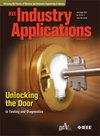基于递归扩展最小二乘的平面开关磁阻电机位置预测控制
IF 4.5
2区 工程技术
Q2 ENGINEERING, ELECTRICAL & ELECTRONIC
引用次数: 0
摘要
模型预测位置控制(MPPC)是平面开关磁阻电机实现高精度轨迹跟踪的一种很有前途的控制方法。然而,由于系统模型与实际系统的不匹配,MPPC的控制性能可能会下降。为了解决这个问题,可以使用在线参数识别作为模型细化的替代方法。为了提高实验室研制的PSRM系统的轨迹跟踪性能,提出了一种基于递推扩展最小二乘(RELS)的MPPC方法。建立了PSRM的常规动力学模型和基于rels的参数识别动力学模型。采用参数辨识动态模型建立预测模型,并在线更新模型参数。根据所建立的预测模型和定义的成本函数推导出控制律,并对系统的稳定性进行了分析。仿真和实验结果表明,PSRM系统的轨迹跟踪性能得到了改善。验证了该方法的有效性。本文章由计算机程序翻译,如有差异,请以英文原文为准。
Recursive-Extended-Least-Squares-Based Model Predictive Position Control for the Planar Switched Reluctance Motor
Model predictive position control (MPPC) is a promising control method for planar switched reluctance motors (PSRMs) to achieve high-precision trajectory tracking. However, the control performance of MPPC may deteriorate due to a mismatch between the system model and the actual system. To address this issue, online parameter identification can be used as an alternative method to model refinement. In this paper, an MPPC method based on recursive extended least squares (RELS) is proposed to improve the trajectory tracking performance of a laboratory-developed PSRM system. The conventional dynamic model and RELS-based parameter identification dynamic model for the PSRM are established. The predictive model is developed using the parameter identification dynamic model, with its parameters updated online. The control law is derived from the developed predictive model and the defined cost function, and the system stability is subsequently analyzed. The simulation and experimental results show improvement in the trajectorytracking performance of the PSRM system. The effectiveness of the proposed method is verified.
求助全文
通过发布文献求助,成功后即可免费获取论文全文。
去求助
来源期刊

IEEE Transactions on Industry Applications
工程技术-工程:电子与电气
CiteScore
9.90
自引率
9.10%
发文量
747
审稿时长
3.3 months
期刊介绍:
The scope of the IEEE Transactions on Industry Applications includes all scope items of the IEEE Industry Applications Society, that is, the advancement of the theory and practice of electrical and electronic engineering in the development, design, manufacture, and application of electrical systems, apparatus, devices, and controls to the processes and equipment of industry and commerce; the promotion of safe, reliable, and economic installations; industry leadership in energy conservation and environmental, health, and safety issues; the creation of voluntary engineering standards and recommended practices; and the professional development of its membership.
 求助内容:
求助内容: 应助结果提醒方式:
应助结果提醒方式:


